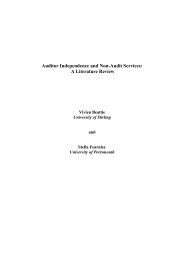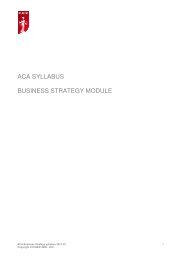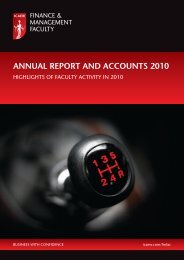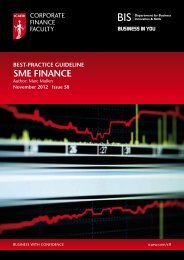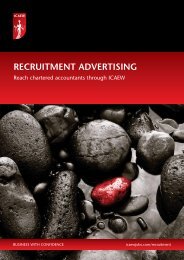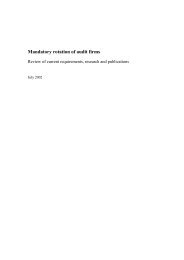Acting in the public interest â a framework for analysis - ICAEW
Acting in the public interest â a framework for analysis - ICAEW
Acting in the public interest â a framework for analysis - ICAEW
- No tags were found...
Create successful ePaper yourself
Turn your PDF publications into a flip-book with our unique Google optimized e-Paper software.
One way of deal<strong>in</strong>g with a position <strong>in</strong> which <strong>the</strong>re is a loss to one set of people <strong>in</strong> order tobenefit ano<strong>the</strong>r, would be to arrange offsett<strong>in</strong>g payments, <strong>for</strong> example a lump sum to offset lossof future benefits. Ano<strong>the</strong>r way would be to settle <strong>for</strong> an alternative outcome where everyone isat least no worse off even if it is, <strong>in</strong> some terms, <strong>the</strong>oretically sub optimal to ano<strong>the</strong>r outcome.This is position C <strong>in</strong> Panel 8.4. A third way is to conclude that <strong>the</strong> <strong>in</strong>terests of <strong>the</strong> section be<strong>in</strong>gbenefited are more important, <strong>in</strong> this respect at least, than those of <strong>the</strong> disadvantaged section.An example of this is welfare payments to <strong>the</strong> poor, funded by taxation on <strong>in</strong>comes of thosebetter off. This <strong>in</strong>volves weight<strong>in</strong>g of <strong>in</strong>terests.Whatever method is used, this is likely to be a key consideration <strong>in</strong> assessment by o<strong>the</strong>rs as towhe<strong>the</strong>r <strong>the</strong> action really is <strong>in</strong>tended to be <strong>in</strong> <strong>the</strong> <strong>public</strong> <strong>in</strong>terest or is more of a smokescreen,hav<strong>in</strong>g been subject to undue <strong>in</strong>fluence. Transparency is particularly important here. This is notto say that <strong>the</strong> process of <strong>the</strong> decision should take precedent over <strong>the</strong> outcome: while <strong>the</strong>re maybe pragmatic issues that result <strong>in</strong> a less than optimal outcome, that substandard outcome can hardlybe justified as be<strong>in</strong>g <strong>in</strong> <strong>the</strong> <strong>public</strong> <strong>in</strong>terest if it is caused by prioritis<strong>in</strong>g appearance over all else.Given <strong>the</strong> tendency to concentrate on expressed <strong>in</strong>terest (discussed above) use of <strong>public</strong> vot<strong>in</strong>gand or generally supported custom and law can be safer options. 1988.3 Practical ways <strong>for</strong>wardMeasurement is <strong>the</strong>oretically simple, but <strong>in</strong> practice sensible numbers are difficulty to come by.Weight<strong>in</strong>g is possible and <strong>in</strong>deed has to be done. However, it is fraught with difficulty. How,<strong>the</strong>re<strong>for</strong>e, do those advocat<strong>in</strong>g <strong>public</strong> <strong>in</strong>terest positions actually determ<strong>in</strong>e whose <strong>in</strong>terests areto be considered and how to deal with conflicts?One option is to determ<strong>in</strong>e that <strong>the</strong>re is a ‘w<strong>in</strong>–w<strong>in</strong>’ situation: everyone is better off or at leastsome are better off and no-one is harmed. As noted <strong>in</strong> <strong>the</strong> discussion <strong>in</strong> Panel 8.4 on Paretoefficiency, this can arrive at a quite different solution to one <strong>in</strong> which <strong>the</strong>re are w<strong>in</strong>ners and losers.Given <strong>the</strong> wide divergence of op<strong>in</strong>ions and circumstances, <strong>the</strong>re is seldom an agreed view that<strong>the</strong>re has been a w<strong>in</strong>-w<strong>in</strong> anyway, or even if it is, that <strong>the</strong> allocation of ‘w<strong>in</strong>’ is fair and reasonable.However, divergent views can be taken advantage of to achieve this: if <strong>the</strong>re are differentexpectations as to what will happen, it may be possible to construct an arrangement where allparties th<strong>in</strong>k <strong>the</strong>y will w<strong>in</strong>, 199 <strong>for</strong> example fix<strong>in</strong>g upper and lower limits on a price (a cap andcollar arrangement), where <strong>the</strong> parties both regard <strong>the</strong> pric<strong>in</strong>g as <strong>in</strong> <strong>the</strong>ir <strong>in</strong>terests, due todifferent expectations as to volume.Where <strong>the</strong>re are positive and negative attributes to be considered, as is usually <strong>the</strong> case withsocial decision mak<strong>in</strong>g, impact <strong>analysis</strong> is a useful means of assess<strong>in</strong>g <strong>the</strong> net effect. It alsoassists <strong>in</strong> demonstrat<strong>in</strong>g <strong>the</strong> decision taken.One suggestion made, as a means of comb<strong>in</strong><strong>in</strong>g <strong>the</strong> best parts of all approaches, is <strong>the</strong> use of‘<strong>in</strong><strong>for</strong>med <strong>in</strong>tuition’. 200 This, <strong>in</strong> essence, takes aspects of <strong>the</strong> Bazerman approach – assess <strong>the</strong>problem, consider <strong>the</strong> goals and <strong>the</strong>ir importance, consider what actions would facilitate whatgoals – and <strong>the</strong>n make an <strong>in</strong>tuitive judgement, monitor<strong>in</strong>g your emotional reaction to differentoptions. It can also be applied <strong>the</strong> o<strong>the</strong>r way around – as noted above it is difficult to switchoff <strong>in</strong>tuition, so <strong>the</strong> rational calculation process can be used to act as a logic check on what<strong>in</strong>tuition has suggested <strong>in</strong> <strong>the</strong> first place.This approach is perhaps of more value to <strong>in</strong>dividuals than regulators or o<strong>the</strong>r accountableorganisations although even <strong>in</strong> <strong>the</strong> latter it <strong>in</strong>dicates that ‘gut feel’ can be valuable if it can bejustified as not be<strong>in</strong>g subverted by <strong>in</strong>appropriate <strong>in</strong>fluences.8.4 Chapter summaryThe advocate of a <strong>public</strong> <strong>in</strong>terest action needs to apply, and be seen to be apply, judgementto <strong>in</strong><strong>for</strong>mation ga<strong>the</strong>red about <strong>in</strong>dividual wants, needs and o<strong>the</strong>r constra<strong>in</strong>ts to wants. Theremay be a series of measurement issues to overcome, <strong>in</strong>clud<strong>in</strong>g: quantification; <strong>in</strong>teraction;weight<strong>in</strong>g; and how to maximise <strong>the</strong> end result when <strong>the</strong>re may be several acceptable solutions.A logical approach is needed to determ<strong>in</strong>e what outcome would be <strong>in</strong> <strong>the</strong> <strong>public</strong> <strong>in</strong>terest, or <strong>in</strong> <strong>the</strong>case of multiple positive outcomes, most <strong>in</strong> <strong>the</strong> <strong>public</strong> <strong>in</strong>terest. A decision based on a rationalbasis of calculation will assist transparency but is easier said than done. Use of <strong>in</strong><strong>for</strong>med <strong>in</strong>tuitionand impact <strong>analysis</strong> may be relevant, although this will at least partially depend on <strong>the</strong> natureof <strong>the</strong> advocate.198Desk<strong>in</strong>s, ‘On <strong>the</strong> Nature of <strong>the</strong> Public Interest’.199Brandenburger and Nalebuff, ‘The Right Game: Use Game Theory to Shape Strategy’.200Thagard, How to Make Decisions: Coherence, Emotion and Practical Inference.Aggregation and decision59



